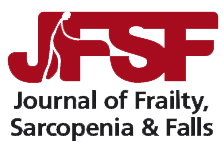Original Article JFSF, Vol 8, No 1, March 2023, p.1-8
Muscle power predicts frailty status over four years: A retrospective cohort study of the National Health and Aging Trends Study
Caitlin M. Burbank, Adam Branscum, Marit L. Bovbjerg, Karen Hooker, Ellen Smit
Keywords: Aged, Chair rise, Frailty, Functional status, Muscle power
Abstract
Muscle power predicts frailty status over four years: A retrospective cohort study of the National Health and Aging Trends Study
Caitlin M. Burbank, Adam Branscum, Marit L. Bovbjerg, Karen Hooker, Ellen Smit
Keywords: Aged, Chair rise, Frailty, Functional status, Muscle power
Abstract
Objectives: Muscle power is a critical measure of physical capacity in older adults, however the association between muscle power and frailty is not well explored. The purpose of this study is to estimate the association between muscle power and frailty in community-dwelling older adults in the National Health and Aging Trends Study from 2011-2015. Methods: Cross-sectional and prospective analyses were performed on 4,803 community-dwelling older adults. Mean muscle power was calculated using the five-time sit-to-stand test, height, weight, and chair height and dichotomized into high-watt and low-watt groups. Frailty was defined using the five Fried criteria. Results: The low watt-group had higher odds of pre-frailty and frailty at baseline year 2011. In prospective analyses, the low-watt group that was pre-frail at baseline had increased hazards of frailty (AHR 1.62, 95% CI 1.31, 1.99) and decreased hazards of non-frailty (AHR 0.71, 95% CI 0.59, 0.86). The low-watt group that was non-frail at baseline had increased hazards of pre-frailty (1.24, 95% CI 1.04, 1.47) and frailty (1.70, 1.07, 2.70). Conclusions: Lower muscle power is associated with higher odds of pre-frailty and frailty and increased hazards of becoming frail or pre-frail over four years in those who are pre-frail or non-frail at baseline.
PDF 